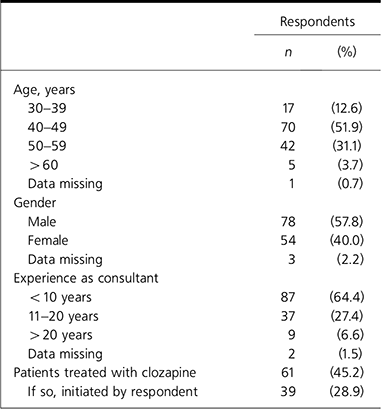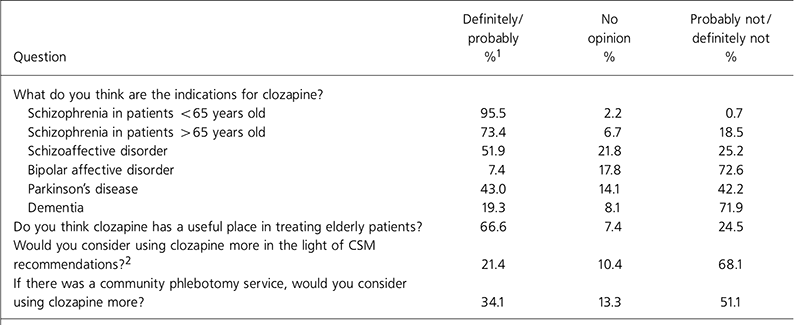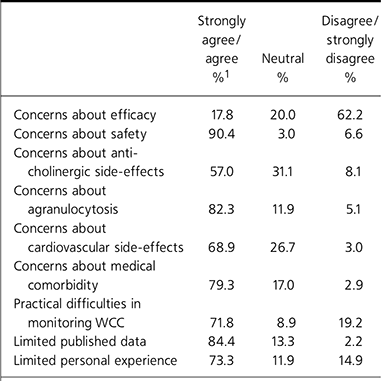With increased life expectancy the number of older patients with psychoses is expected to rise (Reference Jeste, Eastham and LacroJeste et al, 1996). Antipsychotic drugs are the most effective treatment for late-onset psychosis; however, a significant proportion of patients do not respond to conventional and/or atypical antipsychotics, and treatment resistance may be more common in elderly people than in younger adults with schizophrenia (Reference Tran-Johnson, Krull and JesteTran-Johnson et al, 1992). Clozapine is an atypical antipsychotic that is widely used in treatment-resistant psychosis and significantly improves quality of life and social functioning (Reference BachanaBachana, 1995). Case reports, open-label studies and double-blind comparison studies have concluded that clozapine at a relatively low mean dosage (134 mg per day) is safe and effective for elderly patients with treatment-resistant psychosis and that patients are able to continue treatment for extended periods (Reference Sajatovic, Jaskiw and KonickiSajatovic et al, 1997; Reference Barak, Wittenberg and NaorBarak et al, 1999; Reference Howanitz, Pardo and SmelsonHowanitz et al, 1999). Agranulocytosis owing to clozapine is more frequent than in younger adults and should be monitored carefully. Active monitoring of patients treated with clozapine has reduced predicted agranulocytosis rates (Reference HonigfeldHonigfeld, 1996) and ensured adherence (Reference Munro, O'Sullivan and AndrewsMunro et al, 1999). Reports suggest that clozapine may be successfully used to treat psychosis associated with Parkinson’s disease (Reference Poewe and SeppiPoewe & Seppi, 2001). However, a recent study from the UK found that clozapine usage was proportionately lower among older patients with psychosis compared with adults of working age (Reference Woodall, Menkes and TrevelyanWoodall et al, 2004). To explore why this might be so, a postal questionnaire was devised to survey the practices and attitudes towards clozapine of consultants in old age psychiatry in England.
Method
The questionnaire covered the following areas: consultants’ own experience of using clozapine; their views of clozapine’s usefulness in elderly patients; and their views on the barriers to using clozapine in older adults. In addition, the questionnaire included a section for written open comments.
It was sent initially to 10 local consultants in old age psychiatry to pilot its suitability and ease of use. The questionnaire was modified based on their responses and sent by post to a representative sample of consultants in old age psychiatry in England (n=155) in April 2005, along with a covering letter explaining the purpose of the study and a stamped addressed envelope. The sample was taken randomly from a national database of old age psychiatrists updated in 2004 by the Policy and Social Services Research Unit of the University of Manchester (Professor D. Challis). Questionnaires were marked with a code so that non-responders could be identified but anonymity was maintained. A reminder was sent to non-responders 6 weeks later.
For questions seeking an opinion, a five-point Likert scale was used, ranging from ‘definitely’ to ‘definitely not’, or ‘ strongly agree’ to ‘strongly disagree’. The data were analysed using the Statistical Package for the Social Sciences, version 13.0 for Windows. The χ2 test was used to examine categorical responses.
Results
One hundred and thirty-five replies were received, representing a response rate of 87%. The characteristics of respondents are shown in Table 1, and their responses are analysed in Tables 2 and 3.
Table 1. Characteristics of respondents

| Respondents | ||
|---|---|---|
| n | (%) | |
| Age, years | ||
| 30-39 | 17 | (12.6) |
| 40-49 | 70 | (51.9) |
| 50-59 | 42 | (31.1) |
| > 60 | 5 | (3.7) |
| Data missing | 1 | (0.7) |
| Gender | ||
| Male | 78 | (57.8) |
| Female | 54 | (40.0) |
| Data missing | 3 | (2.2) |
| Experience as consultant | ||
| < 10 years | 87 | (64.4) |
| 11-20 years | 37 | (27.4) |
| > 20 years | 9 | (6.6) |
| Data missing | 2 | (1.5) |
| Patients treated with clozapine | 61 | (45.2) |
| If so, initiated by respondent | 39 | (28.9) |
Table 2. Consultants’ responses to questions concerning the use of clozapine (n=135)

| Question | Definitely/probably %1 | No opinion % | Probably not/definitely not % |
|---|---|---|---|
| What do you think are the indications for clozapine? | |||
| Schizophrenia in patients < 65 years old | 95.5 | 2.2 | 0.7 |
| Schizophrenia in patients > 65 years old | 73.4 | 6.7 | 18.5 |
| Schizoaffective disorder | 51.9 | 21.8 | 25.2 |
| Bipolar affective disorder | 7.4 | 17.8 | 72.6 |
| Parkinson’s disease | 43.0 | 14.1 | 42.2 |
| Dementia | 19.3 | 8.1 | 71.9 |
| Do you think clozapine has a useful place in treating elderly patients? | 66.6 | 7.4 | 24.5 |
| Would you consider using clozapine more in the light of CSM recommendations?2 | 21.4 | 10.4 | 68.1 |
| If there was a community phlebotomy service, would you consider using clozapine more? | 34.1 | 13.3 | 51.1 |
Table 3. Consultants’ views on possible reasons for the limited use of clozapine in elderly patients (n=135)

| Strongly agree/agree %1 | Neutral % | Disagree/strongly disagree % | |
|---|---|---|---|
| Concerns about efficacy | 17.8 | 20.0 | 62.2 |
| Concerns about safety | 90.4 | 3.0 | 6.6 |
| Concerns about anticholinergic side-effects | 57.0 | 31.1 | 8.1 |
| Concerns about agranulocytosis | 82.3 | 11.9 | 5.1 |
| Concerns about cardiovascular side-effects | 68.9 | 26.7 | 3.0 |
| Concerns about medical comorbidity | 79.3 | 17.0 | 2.9 |
| Practical difficulties in monitoring WCC | 71.8 | 8.9 | 19.2 |
| Limited published data | 84.4 | 13.3 | 2.2 |
| Limited personal experience | 73.3 | 11.9 | 14.9 |
Sixty-one consultants (45%) had patients who were prescribed clozapine under their care. Of these consultants, two-thirds (n=39) had initiated clozapine treatment themselves (29% of the whole sample). Almost all consultants had used clozapine for treatment-resistant schizophrenia. A very small proportion had used it for other indications, including schizoaffective disorder, Parkinson’s disease, Lewy body dementia, bipolar affective disorder and other organic psychosis. There was no statistically significant difference between consultants’ age, experience, gender and whether or not they had patients on clozapine under their care. Likewise, there was no statistically significant difference between consultants’ age, gender or experience and their views about clozapine having a useful place in the treatment of the elderly.
A majority of respondents (between 57% and 90%) expressed concerns about the lack of published data, and the safety and side-effects of clozapine in the elderly, or were concerned about physical comorbidity - even though two-thirds (67%) indicated that clozapine had a useful place in the treatment of elderly patients (Table 2). Those who had patients under their care treated with clozapine were more likely to say that it had a useful place in the care of the elderly than consultants who had no patient taking the drug (83.6% v. 51%; χ 2=14.12, P<0.0001). Around two-thirds of the consultants agreed or strongly agreed that limited personal experience with clozapine was a reason for its limited use (Table 3). A third of respondents would consider using clozapine more if a community phlebotomy service were available and a fifth would consider using clozapine more in the light of UK restrictions on the use of atypical antipsychotics in patients with dementia or cerebrovascular risk factors (Committee for the Safety of Medicines, 2004).
Twenty-five additional written comments were made, with two themes emerging: the practical difficulties of regular blood monitoring and a lack of evidence specifically in older patients.
Discussion
The high response rate from a nationally representative sample of old age psychiatrists in consultant posts is encouraging. The majority of consultants agreed that clozapine is effective in the elderly but under half had recent experience with its use. There was a range of concerns regarding its use in older patients, but this survey suggests that familiarity and confidence of consultants are important determinants of its use in older patients. However, there were also concerns about a lack of published data regarding elderly patients and practical difficulties in blood monitoring. Given the community orientation of old age psychiatry in England, there was a specific concern about a lack of community phlebotomy services.
Although not a comparative study, this survey adds to the data that suggest that older patients with schizophrenia are prescribed clozapine less often than younger adult patients (Reference Woodall, Menkes and TrevelyanWoodall et al, 2004). This does not appear to be offset by the prescription off-label of clozapine in other psychotic disorders which occur often in later life, such as the Lewy body-Parkinson’s psychosis spectrum. In part this is a reflection of the lack of data specific for older adults which many respondents highlighted. It seems especially important to advocate such research given an anticipated rise in overall numbers of older patients with psychotic disorders. The results are consistent with a recent survey of the prescription of clozapine to adolescent patients, with similar reasons for non-use cited (Reference CirulliCirulli, 2005).
A further issue identified in our survey concerns the natural tendency of clinicians to feel confident about prescribing treatments they have used successfully and, conversely, reluctance to use ones with which they are unfamiliar such as clozapine. This might be best addressed by training within the context of continuing professional development. Finally, practical barriers to blood monitoring, especially a lack of community phlebotomy services, should be addressed.
Acknowledgements
We are grateful to the consultants who completed the questionnaire. We thank Professor D. Challis of the Policy and Social Services Research Unit, University of Manchester for giving us access to his database of consultant old age psychiatrists. We also thank Barbara Tomenson, University of Manchester, for statistical advice.






eLetters
No eLetters have been published for this article.